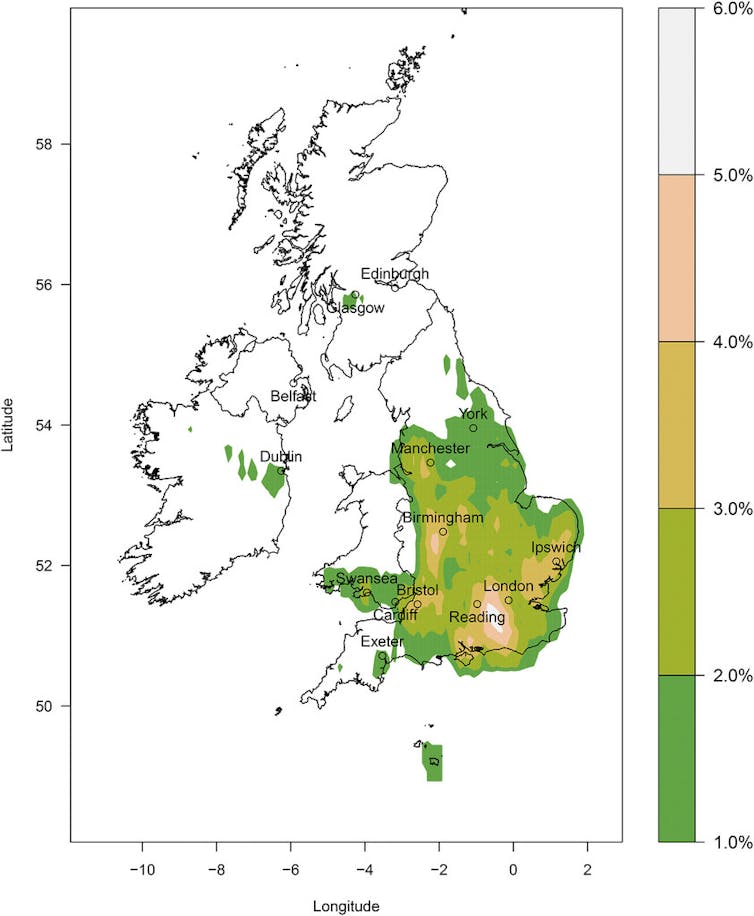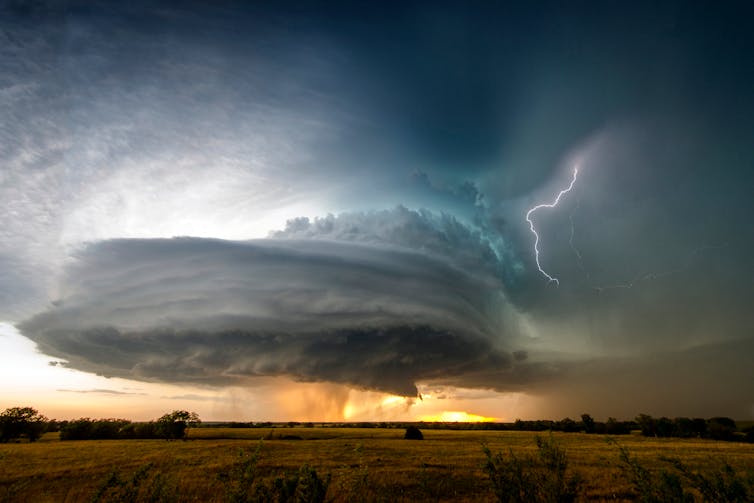Tornadoes in the UK are surprisingly common and no one knows why
By David Schultz, University of Manchester
A small tornado recently passed through the town of Littlehampton on England’s south coast. Strong winds smashed windows, moved cars and left one person injured.
You might associate tornadoes with the plains of the central US, but they’re surprisingly common in the UK too – albeit smaller and weaker. In fact, my former PhD student Kelsey Mulder found that the UK has about 2.3 tornadoes per year per 10,000 square kilometres. That’s a higher density than the US, which as a whole has just 1.3 per 10,000 square km.
The numbers are higher for American states in “Tornado Alley” such as Oklahoma (3.6) or Kansas (11.2). Nonetheless, a random location in the UK is more likely to experience a tornado than a random location in the US.
Mini Tornado Littlehampton pic.twitter.com/t0MuCb7Wxg
— eddie mitchell (@brightonsnapper) September 18, 2023
The data isn’t perfect, however. Tornadoes cannot be observed by satellites and need to be close to weather radars, which can detect the rotation. Thus, most observations are made by humans who then have to report them to the relevant weather service. “Storm-chasers” follow most tornadoes on the American plains, but underreporting may be an issue elsewhere.
Most tornado research has focused on the US, where forecasting and early-warning systems are advanced. There is considerably less research on UK tornadoes. Over the past 12 years, my research group has tried to address this by shedding light on where and when UK tornadoes occur, what causes the storms that produce them and how we can better predict them.
England has three ‘tornado alleys’
Whereas many tornadoes in the US plains occur within a few weeks during the spring, UK tornadoes can occur throughout the year. The UK’s tornado alley is really three regions, most in southern England: an area south of a line between Reading and London with a maximum near Guildford, locations southwest of Ipswich and a line west and south of Birmingham.
These regions have probabilities of experiencing a tornado within a 100 square km area of somewhere between 3% and 6% per year, meaning they could see one as often as every 15 to 30 years.
Tornadoes between 1980 and 2012, mapped by Dr. Kelsey Mulder and the author. Monthly Weather Review, CC BY-SA
These tornadoes aren’t as violent as the more extreme ones in the US, but the damage can still be substantial. In July 2005, a large tornado in Birmingham caused £40 million in damages and injured 39. Fortunately, no one was killed. People have died in the past though, for example a strong tornado in South Wales in 1913 killed three.
Although the Birmingham tornado was the most damaging tornado on that day, two others were recorded across the British Isles. Indeed, around 70% of UK tornado days have at least two reports, and 13% produce three or more.
We refer to such days as tornado outbreaks, with the largest-ever UK tornado outbreak occurring on 23 November 1981, producing 104 tornado reports from Anglesey to Norwich.
What causes tornadoes
We still don’t know exactly why the UK has so many weak tornadoes. We do know that “supercells” – rotating thunderstorms tens of kilometres across – form the largest tornadoes in the US but occur less frequently in the UK. Instead, tornadoes in the UK tend to be formed from lines of storms along cold fronts.
The largest tornadoes are formed from supercell storms, like this one in Kansas. GSW Photography / shutterstock
Although millions of dollars have been spent researching supercell thunderstorms in the US, there is an increasing awareness that these linear storms also require investigation on both sides of the Atlantic. Our group has been trying to understand what causes some of these parent storms to begin to rotate and eventually spawn tornadoes.
So far, my former PhD student Ty Buckingham and I have been able to identify certain conditions where the wind direction changes abruptly. In such cases, an instability may develop where small perturbations grow into rotating vortices a kilometre or more across, regularly spaced along the front. Such vortices are thought to be the precursor for tornadoes.
Identifying the conditions for this so-called “horizontal shearing instability” should mean we can better predict when and where the parent storms that produce the tornadoes form. But understanding this instability is not the only answer. Other tornado-producing storms do not appear to be associated with this instability, so we still have more to learn.
The next step is understanding how the tornadoes themselves form. For that, we will need both fortuitous observations of such tornadoes forming close to Met Office radars and powerful computer programs that are able to model the atmosphere down to a scale of tens of meters.
Recent advances in computing and our collaborations with colleagues in engineering may yet reveal the secrets of UK tornadoes.
David Schultz, Professor of Synoptic Meteorology, University of Manchester
This article is republished from The Conversation under a Creative Commons license. Read the original article.




